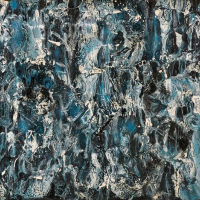60. RALPH BALSON

Ralph Balsons Matter Painting, c1962, combines the 20th century fascination with Einsteins theory of relativity with a first-hand knowledge of mid-century American and European art. The drip and pour approach that informs Matter Painting is reminiscent of Jackson Pollocks painterly abstraction and encapsulates the sensibility of contemporary European tachists Antonio Tpies (1923-2012) and Alberto Burri (19191995), and their embrace of chance processes and the raw qualities of materials.1 Balsons final series (1960-62) represents the exploratory approach of this unique Australian artist and is the culmination of five decades of work.
As Ralph Balsons personal circumstances changed and his life experiences grew so did his art. Having initially studied at the Julian Ashton Art School alongside Grace Crowley (1890-1979), Balson is credited with being among the first Australian painters to devote themselves solely to the pursuit of abstract art. In 1941 he held the first solo exhibition in Australia of entirely non-figurative paintings; bold, highly considered, constructive images, comprising overlapping geometric coloured forms, in a shallow picture plane.2 Later in the 1950s, Balson taught at East Sydney Technical School and focused full-time on his art.
In 1960, Balson travelled overseas for the first time. He visited New York, England and France and was inspired to embark on a radical new series that replaced the molecular or patterned paintings of the mid-1950s with a free-flowing, rapid-fire, chance-driven style. Balson recorded in that year: I can realise that the energy, the atoms that reach us from the sun is the source, the rhythm of existence, and the very narrow band, the spectrum, is all we can ever hope to have to try and reach a small amount of the rhythm and relativity of the universe with the substance of paint.3 This philosophy posited reality as a source of continual movement and matter as a series of transformative relationships. The idea was to transform Balsons practice to its core.
Matter Painting comprises a network of competing forces in a shallow pictorial space. The work compares favourably with a similarly titled and sized painting in the collection of the National Gallery of Australia, Canberra. Signed and dated 1962, this work was donated to the NGA by the artists son. The two works feature a tonal range comprising blues or browns and creams. By deliberately restricting his colour range, Balson felt confident that attention would be drawn to the inherent characteristics of the fluid enamel medium.
There is not a central motif or subject to speak of. Rather there is a sensation or feeling that the paint animates the surface and continues unabated well beyond the frame. Slips, swirls, drips, bleeds and scrapes are the real focus. The fluidity of the paint is evident by the presence of troughs and ridges and the intriguing texture that forms as the painting dries. The enamel paint coagulates, skins, opens up and stretches to form heavy layers and edges that Balson sometimes bulked up with oil paint and sand.
Matter Painting, c1962, represents the culmination of his study of abstract principles in art and is a fine example of the freedom and spontaneous handling of paint that characterised this final series of work. The Matter paintings allude to sub-particle theory but evoke the chaos and flux inherent in everyday life through the inherent properties of paint.
Footnotes
1. National Gallery of Australia collection notes, published on the occasion of the Abstract Expressionism exhibition, 2013
2. Kelly, M., National Gallery of Australia, 2013
3. Quoted in Art Gallery of New South Wales collection notes, http://www.artgallery.nsw.gov.au/collection/artists/balson-ralph/?tab=works
Rodney James BA (Hons); MA